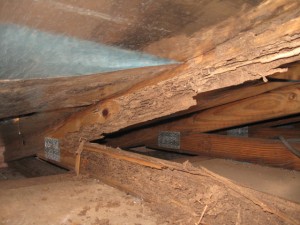The plywood of your roof is typically not as thick as your standard galvanized steel roofing nail, so it is expected for nails to show through this in your attic. The plywood can and is expected to take a bit of damage over time and this is okay as long as the shingle has something firm to hold itself down onto.
Over time if the plywood is too damaged to properly hold down new shingles or becomes too dangerous to walk on safely then a roofer should be able to identify such compromised plywood board and replace it as needed.
What is worrying about your question is that you specified that the roofing nails have split and damaged the roof trusses. Standard roofing nails should not be long or thick enough to split or crack structurally sound dimensional lumber.

If this is what happened then you may have a problem unrelated to the quality of the roofing job. Your home is over 50 years old in a warm wet climate, so you should inspect for a number of different problems.
Dryrot

Termites

Carpenter Ants

If you have any of the following indications of current or past damage to any of the three items then that would explain split, cracked or damaged roof trusses during a typical roofing job.
On another note: The soffit typically fits into a groove that is known as J Channel when installed on a roof overhang. The roof overhang is typically MUCH too tall for any roofing nails to reach soffit. I imagine instead you might be seeing a roofing nails perforating the fascia, which can be a sign of a sloppy rushed job. Without pictures though we can't tell that for sure.




